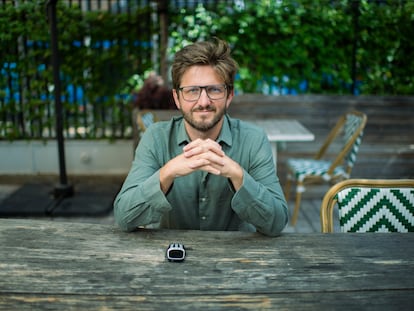Being distracted doesn’t mean you have ADHD: The danger of self-diagnosis in teenagers
In the fight to raise awareness about this disorder, it has become normal to talk about it, but experts warn that, in practice, the problem can end up being trivialized

At the age of eight, visits to the doctor became a routine part of Andrea Belmont’s life. She remembers answering many questions from men in lab coats, tests on “big machines” and starting to take pills every morning. “I didn’t understand what was happening or what I had; I only know that when my mother told the teachers, they treated me differently. And not exactly in a good way,” she admits. It’s been 18 years since she was diagnosed with a four-letter acronym that was difficult for someone her age to understand and which made her feel like an alien: ADHD, attention deficit hyperactivity disorder. But that feeling of being from another planet is very different from what she experiences today. Now she frequently hears comments like “sorry, I got distracted, it’s my ADHD.” And it’s because, according to social networks, if you disconnect from what’s happening around you when someone is talking, you have a tendency to forget things or you concentrate too much when you’re working on a project, you may have it. There is a proliferation of content around this psychiatric disorder; many people identify with the symptoms and take ownership of it, even if they have never received a diagnosis. “It used to be frowned upon and now it’s trendy,” Belmont says.
In the fight to make neurodivergent people visible, the conversation about this disorder in particular, and mental health in general, has become normalized. And although this is a positive thing, in practice it can end up trivializing the problem. Some content creators have gone from raising awareness to encouraging self-diagnosis of ADHD, as has already happened with depression, anxiety, borderline personality disorder and other mental problems that have become fodder for social media and trending material.
Videos tagged with #adhd or #tdah are rife, with more than 17 billion views on TikTok. The videos describe symptoms ranging from absent-mindedness to ADHD paralysis, a type of extreme procrastination. And that content encourages people to turn to other avenues for a quick diagnosis, whether it’s social media or the widely available online tests that have gained popularity but are an inadequate resource. One study found that when adults completed these tests, they were often identified as having ADHD even though they didn’t.
ADHD is a neurodevelopmental disorder that begins in childhood and generally involves inattention, disorganization, hyperactivity and impulsivity; symptoms that cause problems in environments such as home or school. Patients are usually classified into three types: hyperactive and impulsive, inattentive, or a combination of both. Although it is normally identified and treated in childhood, more and more adults claim to suffer from it. Despite the controversy that sometimes surrounds the disorder in adults —just 20 years ago most professionals did not really believe in ADHD in adulthood—, 50% of those affected carry the disorder into adulthood, according to Josep Antoni Ramos Quiroga, head of Psychiatry at Vall d’Hebron Hospital in Barcelona.
Aldo Ferrera places himself among those suspected of having the condition. At 27, he considers himself a scattered person with a very restless mind. Danae Medrano, of the same age, speaks of similar symptoms and adds irritability, forgetfulness, sleeping problems and constant mood swings. Caio Ruvenal, 29, was diagnosed with mild ADHD as a child, but believes he still has it because he has trouble concentrating and loses and forgets objects. They all have in common that they have researched their symptoms in books or on the internet, but have not gone to a specialist in adulthood.
In both children and adults, ADHD symptoms can range “from very mild to very severe,” explains Ramos Quiroga. Bruno Solorio’s case, as he himself describes it, is closer to the latter. He was diagnosed at age 14 and although he abandoned treatment after a few months, he has now resumed it at age 28. “More and more people say they have the same thing as me, but it is very different depending on the person. Mine is very noticeable. It has affected my entire life: in school, work, social and even in love. People think that you are just not interested in things or that you are lazy. And I have the suspicion that those who the world calls losers are just people with ADHD.”
The problems of self-diagnosis
Ramos Quiroga maintains that there is no alarm about an increase in ADHD cases, as the prevalence and incidence have remained “very stable” over time and he even speaks of a possible underdiagnosis in adults. He does acknowledge, however, that as happens to many medical specialists, self-diagnosis encouraged online can be problematic. “There is access to rigorous information on the internet, but there is also other information that is misleading,” he points out.
One of the biggest problems with self-diagnosis is that the condition can be confused with another pathology. There are conditions that can create similar symptoms that make people feel slow, easily distracted and forgetful. Stress, for example, both chronic and acute, can mimic ADHD and cause difficulties with planning, organization and self-regulation. “There are people who have come to the doctor’s office claiming to have ADHD and when we tell them they don’t have it, it even makes them feel uncomfortable. But there are also cases where what they thought was an attention deficit turned out to be autism. Few people know that it is an important risk factor for having other diseases, from depression, addictions or bipolar disorder to type two diabetes.”
A 2017 study found that about 95% of participants who began to show ADHD-like symptoms from the age of 12 did not have the disorder despite matching symptom checklists. This is why a proper diagnosis is necessary and requires several steps: an interview, a medical and developmental history, symptom questionnaires and, if possible, conversations with other people in the patient’s life. Sometimes neurological analysis is also used. Antonio Barrio, from the pediatric neurology center that bears his name, explains that in his specialty they carry out complete analyses of the cognitive abilities of all the functional brain areas: psycholinguistic, psychomotor, socialization and behavioral assessment to channel psychological attention and, if necessary, pharmacological treatment.
The most important recommendation is to assess how it affects daily life. “If I have serious difficulties and there is a significant emotional impact on life, an evaluation is necessary. If the symptoms allow for adequate functioning, it is better not to let things that have been reported without professionals influence me,” explains Ramos. “If there is strong evidence of anxiety, depression or ADHD, then a thorough evaluation is necessary,” he concludes.
Sign up for our weekly newsletter to get more English-language news coverage from EL PAÍS USA Edition
Tu suscripción se está usando en otro dispositivo
¿Quieres añadir otro usuario a tu suscripción?
Si continúas leyendo en este dispositivo, no se podrá leer en el otro.
FlechaTu suscripción se está usando en otro dispositivo y solo puedes acceder a EL PAÍS desde un dispositivo a la vez.
Si quieres compartir tu cuenta, cambia tu suscripción a la modalidad Premium, así podrás añadir otro usuario. Cada uno accederá con su propia cuenta de email, lo que os permitirá personalizar vuestra experiencia en EL PAÍS.
¿Tienes una suscripción de empresa? Accede aquí para contratar más cuentas.
En el caso de no saber quién está usando tu cuenta, te recomendamos cambiar tu contraseña aquí.
Si decides continuar compartiendo tu cuenta, este mensaje se mostrará en tu dispositivo y en el de la otra persona que está usando tu cuenta de forma indefinida, afectando a tu experiencia de lectura. Puedes consultar aquí los términos y condiciones de la suscripción digital.
More information
Archived In
Últimas noticias
Most viewed
- Sinaloa Cartel war is taking its toll on Los Chapitos
- Oona Chaplin: ‘I told James Cameron that I was living in a treehouse and starting a permaculture project with a friend’
- Reinhard Genzel, Nobel laureate in physics: ‘One-minute videos will never give you the truth’
- Why the price of coffee has skyrocketed: from Brazilian plantations to specialty coffee houses
- Silver prices are going crazy: This is what’s fueling the rally










































